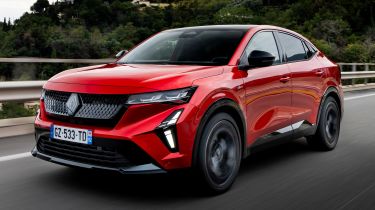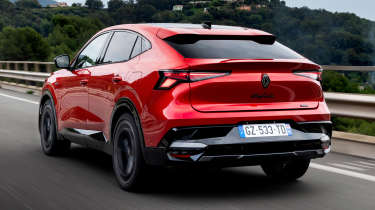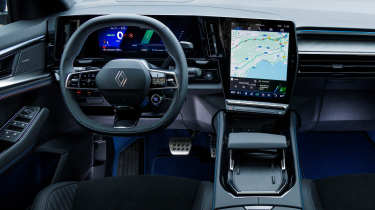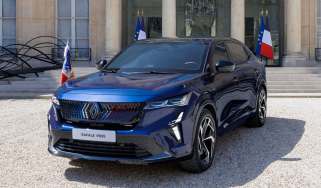New Renault Rafale E-Tech PHEV 2024 review: plug-in power adds to SUV's appeal
The Renault Rafale's new plug-in hybrid powertrain adds desirability, but it's still a flawed SUV that doesn't match up to its premium rivals

Verdict
Thanks to the refinement and tax advantages, the plug-in hybrid Renault Rafale is slightly more appealing than the standard car, but the new propulsion system doesn’t fix the problems altogether. With a £3,500 premium over the hybrid and few significant improvements in the way the car rides and handles, it still can’t quite challenge the premium models with which it hopes to compete.
When we first drove the Renault Rafale, the coupe-SUV ambitiously billed as a rival to the Audi Q3 Sportback left us a little lukewarm. With trendy styling, plenty of space and great on-board technology, it wasn’t short of talents, but it was let down slightly by its uninspiring hybrid system and mediocre driving experience.
But the latest addition to the Rafale range aims to fix that by replacing the conventional hybrid system with a 296bhp plug-in hybrid powertrain that promises low company car tax rates and all-wheel drive, as well as a 60-mile electric-only range.
It delivers that without sacrificing the standard car’s strengths. The striking, modern, and distinctly Peugeot 408-ish design remains unchanged, and interior space is also largely unaltered. Rear cabin space is just as spacious as before, and the boot is still big enough to ensure the Rafale’s luggage bay is more comparable with that of the Q5 Sportback than the smaller Q3.
The interior hasn’t changed much, either, with the same sporty cabin design dominated by a 12-inch, portrait-orientated touchscreen, which uses the Google-powered operating system. It’s highly intuitive and comes with Google Maps, which works as the navigation system as part of a standard specification that’s bursting at the seams.
Even the basic £45,695 Techno Alpine comes with 20-inch alloys, a head-up display and a reversing camera, as well as two-zone climate control, the massive central screen and heated front seats. Moving up to the Atelier Alpine earns you the upgraded suspension, bigger 21-inch wheels and an upgraded sound system, all for a smidge under £50,000.
Renault has kept many of the neat touches that made the hybrid Rafale’s cabin interesting, such as the clever armrest in the centre console, complete with fold-out cupholders and phone stands. But other, less welcome features have been retained, including the mess of stalks behind the steering wheel and the slightly plasticky steering wheel buttons. The latter is especially disappointing, given the Rafale’s build quality is generally solid, if not quite up to the standards of the German brands it claims to challenge.
So far, so familiar, but the Rafale has so far been troubled by its powertrain and driving dynamics, rather than space, design or technology. The plug-in hybrid, though, aims to address the issues with the new powertrain and, in the case of the range-topping Atelier Alpine version, clever suspension that uses a camera to ‘read’ the road ahead, then tune the ride appropriately. At least, that’s the idea.
On the road, the system sacrifices body control in search of comfort that never really materialises, despite the softness of the suspension. The result is a car that bobs awkwardly over bumps, and still manages to find jiggles and imperfections on surfaces previously thought to be silky smooth. In sportier settings, however, the Rafale tightens the leash on that big body slightly, reducing the bobbing sensation over speed bumps but reducing the absorption of the initial impact at the same time. It never gets too jagged, but it is notably firmer than in Comfort mode.
In its Sport and Dynamic settings, Renault says the Rafale is also more fun to drive, but there’s very little evidence of that. The four-wheel steering system is fractionally less nervous than it was in the standard hybrid, but the difference is marginal, and there’s still very little feel for what the front wheels are doing. And though grip is adequate, there isn’t a great deal of poise, so the Rafale doesn’t reward you for driving it hard.
That’s a shame when the performance is commendable. The plug-in hybrid system is based around the same 1.2-litre petrol engine as the less powerful hybrid, albeit with a new turbocharger for a bit more power and a reinforced six-speed automatic gearbox to deal with the extra torque and weight. That’s joined by a collection of three electric motors and a 22kWh battery, which work with the engine and gearbox to produce 296bhp and distribute it between all four wheels.
As a result, the Rafale will get from 0-62mph in 6.4 seconds, which is useful performance, and a vast improvement on the standard Rafale. That power is generally delivered smoothly and peacefully, too, with the noise only really coming when you put your foot down. At least the thrum of the three-cylinder motor is reasonably pleasant.
It’s economical, too. Officially, the Rafale Atelier Alpine has a zero-emission range of up to 59 miles (65 for the Techno Alpine version), and our test suggested such a distance would be achievable in the real world. That’s plenty for most customers to go about their day-to-day business without using the petrol engine at all, but when the engine is called upon, the system still works as a hybrid to keep fuel bills in check. Even with very little charge in the batteries, Renault reckons the Rafale will return the best part of 50mpg. And the electric range and low emissions mean company car tax will be laughably affordable.
| Model: | Renault Rafale E-Tech 4x4 300hp PHEV Atelier Alpine |
| Price from: | £45,695 |
| Price as tested: | £49,695 |
| Engine: | 1.2-litre 3-cyl/ 22kWh battery |
| Power/Torque: | 296bhp/230Nm |
| Transmission: | Six-speed automatic, all-wheel drive |
| 0-62mph: | 6.4 seconds |
| Top speed: | 111mph |
| Economy/CO2: | 404.3mpg/15g/km |
| EV range: | 59 miles |
| Size (L/W/H): | 4,710/2,085/1,613 |
| On sale: | Now |









